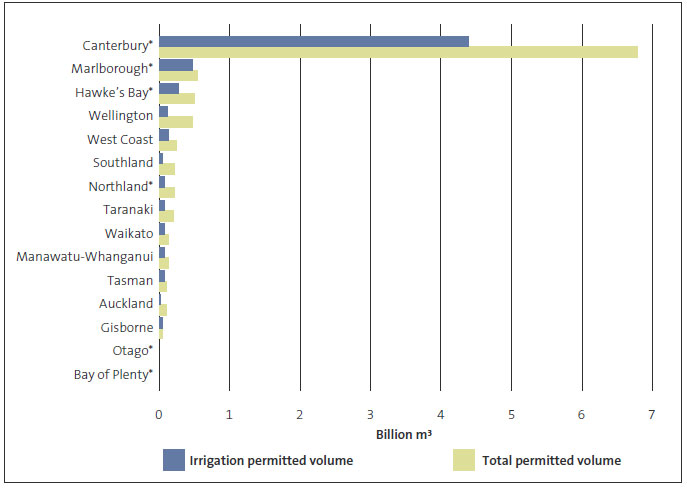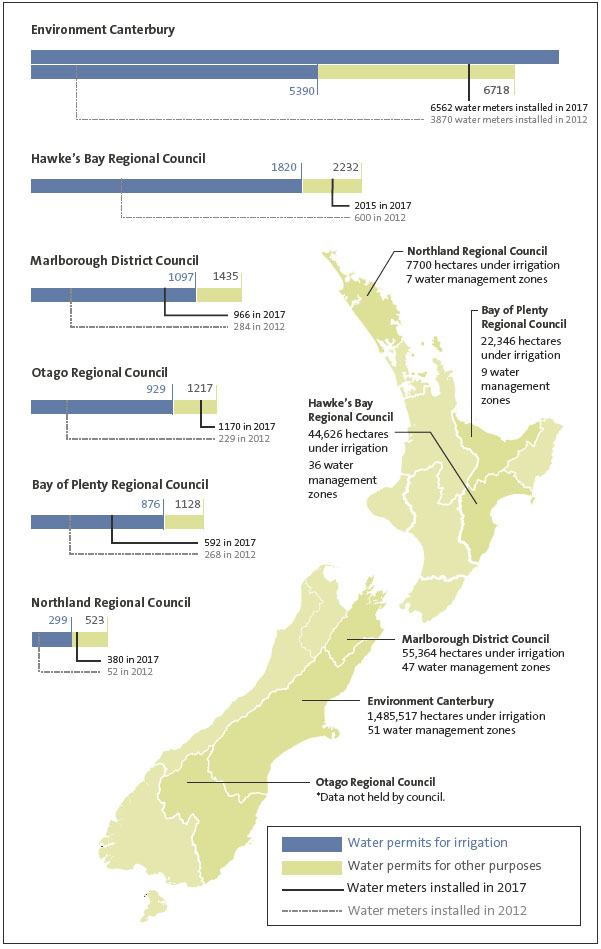Part 1: Introduction
1.1
In this Part, we discuss:
- the purpose of our audit;
- implementing the water measurement regulations;
- what we audited;
- what we did not audit; and
- the structure of this report.
The purpose of our audit
1.2
Freshwater is a vital resource. Large quantities of freshwater are used for irrigation in the agriculture and horticulture industries, with about 65% of water permits allocated to irrigation. This accounts for about 51% of the freshwater permitted for use.1
1.3
Irrigation systems take water from freshwater resources and use it for dairy farming, crops, and fruit – all of which are important in supporting New Zealanders and the economy. When the Resource Management (Measurement and Reporting of Water Takes) Regulations 2010 (the Regulations) were first implemented, irrigation was estimated to have contributed $2.17 billion annually to the economy.2
1.4
Because most of New Zealand's allocated freshwater is used for irrigation, it is particularly important that it is monitored closely. Councils need accurate information about water use at local, regional, and national levels. This information allows the councils managing water to track and make efficient use of allocated water, check compliance with resource consent conditions, and plan for future economic growth.3
1.5
People taking freshwater from its source (such as rivers, lakes, streams, wells, or bores) usually need a resource consent (called a water permit) issued by the relevant council. There are about 11,500 irrigation water permits.
1.6
The Regulations were introduced in November 2010. They required people and organisations holding water permits (permit holders) and taking relatively high quantities of water to measure its use.
1.7
Our 2017/18 work programme has a Water management theme. As part of this theme, we wanted to examine how effective water metering was in creating opportunities for more efficient use of freshwater. We wanted to look at the benefits that had been achieved so far and what could be achieved in the future. We also intended to identify lessons from implementing the Regulations and from using information to support compliance and consenting.
Water measurement regulations
1.8
Before 2010, councils throughout New Zealand used different approaches to measuring water use.
1.9
The Regulations required permit holders who take more than five litres of water each second to measure their water use. This required a water meter. These meters would ensure that water consumption for all purposes was monitored. The Regulations are intended to ensure that definitive and reliable data is available about how much water is used, including for irrigation.
1.10
The Regulations affect most uses of freshwater except, for example, hydroelectric uses.4 Most freshwater use is for irrigation and farming. The Regulations set out how permit holders should record their water use and when and how to provide these records to the council.
1.11
The Regulations were implemented in stages. As shown in Figure 1, permit holders that used the most water were the first to be required to comply with the Regulations.5
Figure 1
Instantaneous rate of water taken and date of required compliance with the Regulations
| The amount of water the permit holder takes … | Date the Regulations came into effect for the permit holder |
|---|---|
| More than 20 litres each second | 10 November 2012 |
| Less than 20 and more than 10 litres each second | 10 November 2014 |
| Less than 10 and more than 5 litres each second | 10 November 2016 |
Source: Ministry for the Environment.
1.12
To ensure that water meters are installed and record water use accurately, they were usually installed by licensed "Blue Tick" contractors.6 After the meters were installed, permit holders were required to provide councils with data at least annually about how much freshwater they were consuming.7 The Regulations do not specify what councils are to do with this information.
1.13
In our view, it is reasonable to expect councils to use this information to improve how communities and the agriculture and horticulture industries use freshwater.
What we audited
1.14
As part of our audit, we looked at:
- how well the implementation of the Regulations has been managed;
- whether water metering is used to collect good quality data;
- whether data is analysed effectively, with useful information shared with permit holders and communities to inform how freshwater is used for irrigation; and
- whether data and information are used to manage use of freshwater for irrigation and to realise efficiencies.
1.15
We selected one unitary and five regional councils (the six councils) to look at for our audit. They were:
- Northland Regional Council;
- Hawke's Bay Regional Council;
- Otago Regional Council;
- Marlborough District Council;
- Bay of Plenty Regional Council; and
- Environment Canterbury.
1.16
We selected these councils because they represent different regional circumstances, with different sizes and volumes of water takes. We selected councils that tend to allocate the most water, because they have the most potential to affect the environment. Figure 2 shows, by region, the total volume of freshwater permitted for use and the volume permitted for irrigation.
Figure 2
Annual freshwater volume permitted for use, by region

*Councils included in our audit.
Source: Land, Air, Water Aotearoa. These figures are what councils are currently and publicly reporting on the Land, Air, Water Aotearoa website – www.lawa.org.nz.
1.17
There are other differences between the six councils. Figure 3 shows the total number of water permits and the number of water permits for irrigation, by region. It also includes some selected data about these councils.
1.18
We reviewed documents, internal processes, and publicly accessible information for all of the six councils. We looked at each council in their own regional context, rather than comparing their performance. All of the examples in this report are from the six councils unless otherwise mentioned.
1.19
To understand different perspectives on the issues about metering, we also spoke with people from the Ministry for the Environment, the Ministry for Primary Industries, the National Institute of Water and Atmospheric Research, Forest & Bird, industry groups (including software companies), and Irrigation New Zealand.
Figure 3
Number of water permits for irrigation and total number of water permits, by region, as at October 2017

Note: Not all water permits require water meters.
Source: Data provided by each council.
What we did not audit
1.20
We did not look at policy decisions. We did not consider the funding of irrigation schemes or councils other than the six councils.
1.21
We did not look at the long-term sustainability of the water measurement infrastructure (such as water meters, data loggers, telemetry,8 or databases).
1.22
Irrigation is linked to wider environmental issues, such as water pollution. Although we did not directly address this as part of our audit, properly timed irrigation can reduce nutrient and effluent leeching into water ways.9 This is why we focus on efficient and sustainable water use by permit holders in Part 4.
1.23
Managing impacts to freshwater quality will be covered in a separate performance audit that we expect to report on later in 2018.
Structure of this report
1.24
In Part 2, we consider how effectively the six councils implemented water metering.
1.25
In Part 3, we discuss water meter data collection and quality, including challenges and improvements.
1.26
In Part 4, we discuss the way councils are using water meter data to help improve behaviours related to the consumption of freshwater.
1: Irrigation accounts for about 5,047 million litres of water out of 9,874 million litres permitted for use (for non-hydro-electricity generation).
2: NZIER and AgFirst Consultants (2014), Value of Irrigation in New Zealand, Wellington.
3: Ministry for the Environment (2010), Measuring and reporting water takes: An introduction to the Resource Management (Measurement and Reporting of Water Takes) Regulations 2010, Wellington.
4: The Regulations do not apply to a water permit if the water being taken is "non-consumptive". Non-consumptive means that the same amount of water is returned to the same water body at or near the location from which it was taken, and there is no significant delay between taking and returning the water.
5: In this report we refer to "high-use permit holders" as those who take 20 litres or more of water each second from their permitted water source.
6: Blue Tick is the quality assurance and accreditation programme developed by Irrigation New Zealand to ensure that contractors who install, verify, and provide data management services comply with the New Zealand Water Measurement Code of Practice and the Regulations.
7: The Regulations provide regional councils with the discretion to approve the keeping of weekly rather than daily records of water consumption.
8: Telemetry is an electronic process for transmitting data from a sensor to, for example, a computer server.
9: Office of the Auditor-General (2011), Managing freshwater quality: Challenges for regional councils, Wellington.

